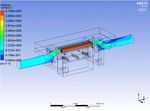Thermal Design of a 100 kW Electron to Gamma Converter at TRIUMF
←
→
Page content transcription
If your browser does not render page correctly, please read the page content below
Journal of Physics: Conference Series
PAPER • OPEN ACCESS
Thermal Design of a 100 kW Electron to Gamma Converter at TRIUMF
To cite this article: B G Cade et al 2018 J. Phys.: Conf. Ser. 1067 032023
View the article online for updates and enhancements.
This content was downloaded from IP address 176.9.8.24 on 30/09/2020 at 05:499th International Particle Accelerator Conference, IPAC18 IOP Publishing
IOP Conf. Series: Journal of Physics: Conf. Series 1067 (2018)
1234567890 ‘’“” 032023 doi:10.1088/1742-6596/1067/3/032023
THERMAL DESIGN OF A 100 KW ELECTRON TO
GAMMA CON-VERTER AT TRIUMF
B G Cade1, L Egoriti1, A Gottberg1, D Priessl2
1
TRIUMF, V6T 2A3 Vancouver, Canada
2
University of Victoria, Dept. of Physics and Astronomy, V8P 5C2 Victoria, Canada
bcade@triumf.ca
Abstract. The electron target station of the TRIUMF-ARIEL Facility will employ an electron
"driver" beam to irradiate Isotope Separator On-Line (ISOL) targets for the production of
radioactive isotopes via photofission [1]. 35 MeV electrons will be converted to gamma
spectrum Bremsstrahlung photons via an electron to gamma (e-γ) converter located upstream
of the ISOL target. The e-γ concept uses a composite metal with two layers: One high-Z
material to stop and convert electrons to photons, and one low-Z material to provide structural
support, thermal dissipation, and maximal transparency to the produced gamma photons as
well as to provide attenuation of remaining primary electrons.. Several material combinations
and bonding processes are currently being evaluated and tested using TRIUMF's e-linac.
Water-cooling and thermal design are being optimized for 100 kW electron beam power
operation and have thus far been experimentally validated up to 10 kW driver beam power
equivalent. The latest test results and future prospects are summarized.
1. Background
Producing isotopes via photofission [1],[2] has the potential to improve the purity of ion beams
available in neutron-rich regions of the chart of nuclides, which is desirable for several of the
experiments at TRIUMF-ISAC [3]. Additionally, a photofission target station can be driven by an e-
linac, allowing a second source of isotope production for TRIUMF’s ISAC facility independent of the
primary 500 MeV proton cyclotron.
The e-γ converter sits immediately upstream of the photofission target within a hermetic target
vessel. The converter is a solid-state concept which consists of a high-Z material layer bonded to low-
Z material layer . 35 MeV electrons strike the high-Z layer of the converter, producing gamma
spectrum Bremsstrahlung photons that then irradiate the photofission target. Worldwide, there is little
precedence in such systems. A similar radioisotope production mechanism is used at ALTO-IPNO [4],
but at significantly lower electron beam power (500 W), allowing for direct irradiation of the target
with electrons without prior conversion to X-rays. Similar converter concepts with lower electron
energies and electron beam power were studied in [5]. The conceptual layout of the TRIUMF-ARIEL
e-γ converter is shown in Figure 1.
2. Thermal Design Concept
The electron irradiation produces a very large heat load. At 100kW of beam power the converter sees
6.0 × 10 W/m of heat flux on the High-Z surface. To dissipate this heat, the Low-Z layer is made
of thermally conductive material (aluminum) machined into a fin array. Various fin geometries were
Content from this work may be used under the terms of the Creative Commons Attribution 3.0 licence. Any further distribution
of this work must maintain attribution to the author(s) and the title of the work, journal citation and DOI.
Published under licence by IOP Publishing Ltd 19th International Particle Accelerator Conference, IPAC18 IOP Publishing
IOP Conf. Series: Journal of Physics: Conf. Series 1067 (2018)
1234567890 ‘’“” 032023 doi:10.1088/1742-6596/1067/3/032023
investigated, however a simple vertical fin array was determined to be advantageous due to
manufacturability and pressure drop requirements.
Figure 1. Layout of the converter and photofission target.
2.1. Cooling Fins
Cooling water approaches the converter perpendicularly to the beam axis, and flows over the fin arrays
on both sides of the converter wedge.
The fins are optimized to maintain the Low-Z material at the lowest possible temperature. ANSYS
CFX CFD [6] software and ANSYS Design Explorer Response Surface Optimization is used to
optimize the flow rate, fin height, fin thickness, and channel thickness to minimize temperature and
pressure drop.
Flow is delivered by a half-inch National Pipe Standard pipe to a diffuser shape that distributes the
flow evenly across the converter fins. This diffuser is shown in cross-section in Figure 3 and the
resultant flow distribution in Figure 2.
Figure 2. Cross-section through the horizontal plane along the beam
axis showing flow balance in water between all fins.
2.2. Optimal Fin Geometry
The selected optimized fin geometry is 4 mm tall fins, 1.2 mm thick, with 1.2 mm thick channels
between them. At 100 kW of beam power and 50 liters per minute (L/min) of water flow the resultant
performance is summarized in Table 1. An average effective convective heat transfer coefficient of
58,000 W/m2K is achieved, within the range of water nucleate boiling.
Fin efficiency is typically a desirable parameter to maximize in fin array designs, as a more efficient
fin typically will remove more heat from the cooled body, however a low fin efficiency must be
accepted to avoid film boiling of the water in the bottom of the fin channels.
29th International Particle Accelerator Conference, IPAC18 IOP Publishing
IOP Conf. Series: Journal of Physics: Conf. Series 1067 (2018)
1234567890 ‘’“” 032023 doi:10.1088/1742-6596/1067/3/032023
Figure 3. Cross-section through the vertical Figure 4. Response Surface of fin optimization
plane along the beam axis of the converter showing temperature as a function of fin
weldment with diffuser shape designed to thickness and channel thickness.
evenly distribute flow across all fins. Arrows
indicate flow direction.
Table 1. Optimal Fin Performance
Value Units
Effective Heat Transfer Coefficient 58,000 W/m K
Maximum Aluminum Temperature 350 ℃
Pressure Drop 1 kPa
Fin Efficiency 16 %
2.3. ANSYS CFX Validation
As the converter is operating within the range of possible nucleate boiling effects it is important to
consider this in the CFD simulations. The RPI boiling model used for nucleate boiling simulation in
ANSYS CFX is developed and validated for large surface areas such as in boilers and pressure vessels
[7], however the very small areas present in the e-γ converter concept may introduce boiling model
inaccuracies and therefore are validated via experiment.
A test bench was built to replicate the power density of 10 kW electron beam power on a scaled
down prototype converter, shown in Figure 5. A TIG welder is applied to a copper block which dif-
fuses the heat before it reaches the aluminium converter prototype. Temperature measurements were
taken in the body of the converter at three locations and several flow rates. This test bench is shown in
Figure 6.
39th International Particle Accelerator Conference, IPAC18 IOP Publishing
IOP Conf. Series: Journal of Physics: Conf. Series 1067 (2018)
1234567890 ‘’“” 032023 doi:10.1088/1742-6596/1067/3/032023
Figure 5. Prototype converter in housing; converter fins Figure 6. Validation testing apparatus.
are copper surrounded by aluminum housing and a clear
polycarbonate lid. Graphite thermally isolates the
converter. Heat is applied to the bottom (not visible).
The test bench was recreated in ANSYS CFX (shown in Figure 7) and analysed with RPI boiling on
or off for each flow rate case conducted previously.
Temperature measurements were compared between the three thermocouple measurements on the
prototype and three point measurements in the ANSYS CFX model. The relative % difference between
the experimental temperature measurements and the CFX results is calculated as the flow rate is varied
and RPI boiling model is turned on or off. shown in Figure 8. CFX validation has shown that as long
as nucleate boiling is properly accounted for via the RPI model, this approach to thermal design of the
converter will have an average error less than 10%.
Figure 7. ANSYS CFX Converter Prototype Figure 8. Maximum % difference found between
showing flow velocity through the vertical CFX simulations and experimental validation of
mid plane. converter fins with RPI boiling model off and on.
49th International Particle Accelerator Conference, IPAC18 IOP Publishing
IOP Conf. Series: Journal of Physics: Conf. Series 1067 (2018)
1234567890 ‘’“” 032023 doi:10.1088/1742-6596/1067/3/032023
2.4. Future Prospects
The high flow rates deemed necessary for thermal design cause concern for the corrosion-erosion
performance of the aluminium fins. Long term high-velocity flow tests are ongoing to examine the
effect of sustained corrosion-erosion on the converter, which could lead to investigations of hardening
or coating the fins.
3. Conclusion
Numerical thermal design, development, and benchtop validation tests of the TRIUMF-ARIEL
electron-to-gamma converter have produced a feasible concept to withstand irradiation with 100 kW
of 35 MeV electrons.
4. Acknowledgements
ARIEL is funded by the Canada Foundation for Innovation (CFI), the Provinces of AB, BC, MA, ON,
QC, and TRIUMF. TRIUMF receives federal funding via a contribution agreement with the National
Research Council of Canada. The authors acknowledge additional support from D. Karlen and P.
Poffenberger (Department of Physics and Astronomy, University of Victoria).
References
[1] Dilling, J., Krücken, R. & Merminga, L. Hyperfine Interact, 2014, 225: 253,
https://doi.org/10.1007/s10751-013-0906-6
[2] Y.T. Oganessian, S.N. Dmitriev, J. Kliman, O.A. Maslov, G.Y. Starodub, A.G. Belov, S.P.
Tretiakova, “RIB production with photofission of uranium”, Nucl. Phys. A 701 1-4, 2002,
87c–95c.
[3] A. Gottberg, “Target materials for exotic ISOL beams”, Nuclear Instruments and Methods in
Physics Research Section B: Beam Interactions with Materials and Atoms, vol. 376, 2016,
pp. 8-15, ISSN 0168-583X, https://doi.org/10.1016/j.nimb.2016.01.020
[4] Franchoo, S., Proc. Conf. Advances in Radioactive Isotope Science (ARIS2014) JPS Conf.
Proc. 6, 020041 (2015).
[5] Gao, Q., Zha, H., Chen, H., & Shi, J., “Design and optimization of the target in electron linear
accelerator”, in Proc. IPAC2013, Shanghai, China, ISBN 978-3-95450-122-9.
[6] ANSYS 18.2, ANSYS Inc. Southpointe, 2600 ANSYS Drive, Canonsburb, PA, 15317, USA.
[7] Rzehak, R., & Krepper, E., “CFD for Subcooled Flow Boiling: Parametric Variations”, in
Science and Technology of Nuclear Installations, 2013, DOI: 10.1155/2013/687494
5You can also read


























































